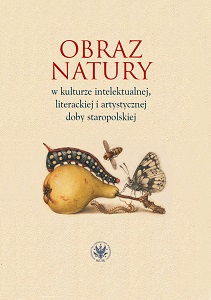Małpa i lustro. O kilku aspektach pojęcia natury w dawnej refleksji estetycznej
A Monkey and a Mirror. Nature in Old Aesthetic Reflexion
Author(s): Barbara Niebelska-Rajca
Subject(s): Cultural history, Studies of Literature, Theory of Literature
Published by: Wydawnictwa Uniwersytetu Warszawskiego
Keywords: aesthetics; ancient philosophy; mimesis; art and nature; belle nature; Marsilio Ficino; Francesco Patrizi; Philip Sidney; Federico Zucchari; aping; symbol of ape; imitatio naturae; artistic creation
Summary/Abstract: In early modern and modern aesthetics inherited from ancient philosophy the notion of nature provided essential context for the theory of creativity and an indispensable element of the definition of art (techne, ars). Under the doctrine of mimesis nature was an idea which, on the one hand, founded and systematised the notion of art but, on the other, competed with it. The rivalry between art and nature was especially seen in Mannerism: the classic 17th century doctrine postulated enhancing and idealising the works of nature (natura naturata); later it was also advocated by Enlightenment Classicists(the idea of belle nature). The article presents several essential meanings which were attributed to the notion of nature in the theories of art and literature between the 15th and 18th centuries. It emphasises the importance of self-causing nature (natura naturans), which in the 15th century aesthetics thought (M. Ficino) became a model to explain the process of creation and its relation with deliberate and rational acts of nature. The natura naturans category was crucial to aesthetics theories which emphasised the creative aspect of creation. It was frequently used by theoreticians such as F. Patrizi, Ph. Sidney, F. Zucchari, who opposing the rule of imitatio naturae understood as passive imitating, aping nature, compared an artist to creative nature or called him the “other nature”. The notion of natura naturans like the Neoplatonist idea of plastic nature had a universal meaning for early modern and Enlightenment theories of art. The analogy between artistic creation and creative nature proved to be more inspiring and useful in modern aesthetics than the famous Renaissance comparison of an artist and creating God.
Book: Obraz natury w kulturze intelektualnej, literackiej i artystycznej doby staropolskiej
- Page Range: 164-180
- Page Count: 17
- Publication Year: 2020
- Language: Polish
- Content File-PDF

